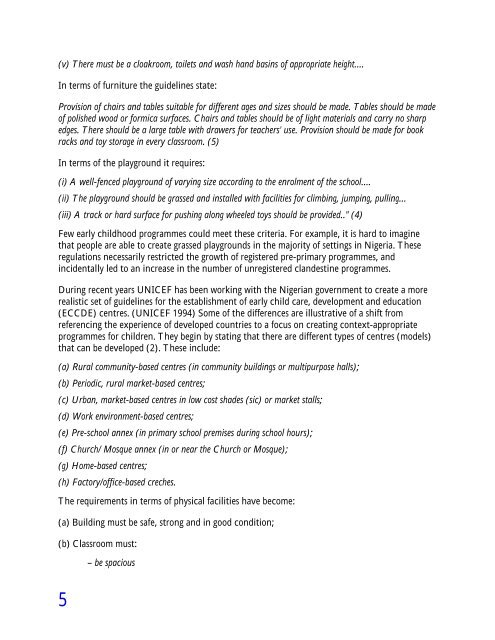How Policy Affects Early Childhood Care and Development.
How Policy Affects Early Childhood Care and Development.
How Policy Affects Early Childhood Care and Development.
Create successful ePaper yourself
Turn your PDF publications into a flip-book with our unique Google optimized e-Paper software.
(v) There must be a cloakroom, toilets <strong>and</strong> wash h<strong>and</strong> basins of appropriate height....<br />
In terms of furniture the guidelines state:<br />
Provision of chairs <strong>and</strong> tables suitable for different ages <strong>and</strong> sizes should be made. Tables should be made<br />
of polished wood or formica surfaces. Chairs <strong>and</strong> tables should be of light materials <strong>and</strong> carry no sharp<br />
edges. There should be a large table with drawers for teachers' use. Provision should be made for book<br />
racks <strong>and</strong> toy storage in every classroom. (5)<br />
In terms of the playground it requires:<br />
(i) A well-fenced playground of varying size according to the enrolment of the school....<br />
(ii) The playground should be grassed <strong>and</strong> installed with facilities for climbing, jumping, pulling...<br />
(iii) A track or hard surface for pushing along wheeled toys should be provided.." (4)<br />
Few early childhood programmes could meet these criteria. For example, it is hard to imagine<br />
that people are able to create grassed playgrounds in the majority of settings in Nigeria. These<br />
regulations necessarily restricted the growth of registered pre-primary programmes, <strong>and</strong><br />
incidentally led to an increase in the number of unregistered cl<strong>and</strong>estine programmes.<br />
During recent years UNICEF has been working with the Nigerian government to create a more<br />
realistic set of guidelines for the establishment of early child care, development <strong>and</strong> education<br />
(ECCDE) centres. (UNICEF 1994) Some of the differences are illustrative of a shift from<br />
referencing the experience of developed countries to a focus on creating context-appropriate<br />
programmes for children. They begin by stating that there are different types of centres (models)<br />
that can be developed (2). These include:<br />
(a) Rural community-based centres (in community buildings or multipurpose halls);<br />
(b) Periodic, rural market-based centres;<br />
(c) Urban, market-based centres in low cost shades (sic) or market stalls;<br />
(d) Work environment-based centres;<br />
(e) Pre-school annex (in primary school premises during school hours);<br />
(f) Church/ Mosque annex (in or near the Church or Mosque);<br />
(g) Home-based centres;<br />
(h) Factory/office-based creches.<br />
The requirements in terms of physical facilities have become:<br />
(a) Building must be safe, strong <strong>and</strong> in good condition;<br />
(b) Classroom must:<br />
– be spacious<br />
5
















